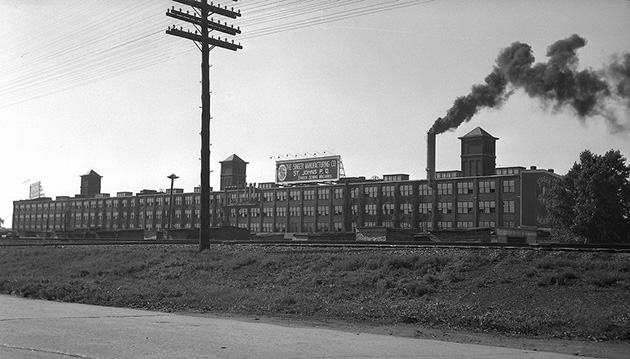Update (2013-08-23) : Many thanks to those who sent me some information about this place. So, it seems like this building was used to heat other buildings of the military complex who is now abandoned.
It is rather unusual that I can not...
Destroyed by mechanical shovels in 2011, it is a true slice of history of the city of Saint-Jean-sur-Richelieu who was destroyed that day in February. The adventure of the Singer factory has lasted over 100 years and has gave work to thousand of people from the district of the Notre-Dame Auxiliatrice parish (Saint-Jean area, adjacent to the plant).
It was in 1904 that the history of the Singer begins at Saint-Jean-sur-Richelieu, 50 years after the construction of the first factory of the company in New York (1851). Inaugurated in 1906, the St-Jean's plant will be 25 times larger than the first plant opened in the country in 1883, in Montreal.
Why Saint-Jean-sur-Richelieu? The choice of the city comes from a variety of tax advantages granted to Singer like exemptions from municipal and school taxes for 20 years, tax credits, construction of a railway for the exclusive use of the Singer, $ 20,000 of funding, donation of the land and those around the plant for residential construction for employees, etc.. In total, $ 500,000 in various grants that are offered to company. An astronomical sum for the time.
Construction requires more than 800 employees and will last two years.

Singer in 1911
Credit: Fernand Hébert - Virtual Museum of Canada
During the Second World War, the factory will be adapted in order to build war materials. Once the war ended, the plant will restart to build sewing machines. The directors of the company take the opportunity to upgrade facilities by building, among others, a new foundry, new warehouses and two garages. In total, six million will be invested. While its area was 580,000 square feet, it will grow to over 900,000 square feet once the expansion will be completed in 1952. These renovations will mark the beginning of the golden age of the plant. Sewing machines manufactured in Saint-Jean-sur-Richelieu will be shipped in more than 48 countries.

L'usine de la Singer en 1945
Credit: Bibliothèque et Archives nationales du Québec - Benoit Brouillette - Virtual Museum of Canada
Ironically, this period also marked the beginning of the end. While many sections are modernized, we begin to close some others departments in order to transfer part of the production to other countries, including Brazil and Scotland.
Today, there are on the former site of the Singer factory, condominium towers and shops. Factory's look and feel with its red brick panels has inspired the new construction. At least, the spirit of the old factory has been preserved.
Update (2013-08-23) : Many thanks to those who sent me some information about this place. So, it seems like this building was used to heat other buildings of the military complex who is now abandoned.
It is rather unusual that I can not...
We are talking about over 5000 years of mining history in this area. The landscape has been changed forever, and it looks at some places like a alien planet where red, yellow, purple mingle with green, gray and ocher.
The ten abandoned...
Used as a snow dump, the site of the former Francon quarry (now known as the Saint-Michel quarry) looks like a huge crater of greenery in the heart of Montreal. This area covers approximately 20% (17% to be exact) of the district of Saint-Michel...
Heavily damaged by the time, the old copper mine is closed for several years. While its lower floors are completely flooded with muddy and stagnant water, the ground floor was, meanwhile, weakened by a sedimentary rock ceiling that collapsed in...